Cromwell tank
| Tank, Cruiser, Mk VIII, Cromwell (A27M) | |
|---|---|
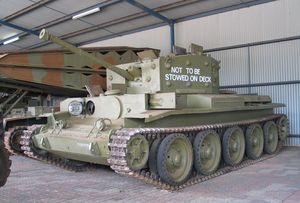 Museum Cromwell. |
|
| Type | Cruiser tank |
| Place of origin | |
| Service history | |
| In service | - |
| Used by | British Army |
| Wars | World War II, 1948 Arab–Israeli War |
| Production history | |
| Designer | Leyland, then Birmingham Railway Carriage and Wagon Company from 1942[1] |
| Manufacturer | Nuffield Organisation |
| Number built | 4,016 |
| Specifications | |
| Weight | 27.6 long tons (28 tonnes) |
| Length | 20 ft 10 in (6.35 m) |
| Width | 9 ft 6½ in (2.908 m) |
| Height | 9 ft 3½ in (2.832 m) |
| Crew | 5 (Commander, gunner, loader, driver, co-driver) |
|
|
|
| Armour | 3 inches (76 mm) |
| Primary armament |
OQF 75 mm |
| Secondary armament |
2 x 7.92 mm Besa machine gun |
| Engine | Rolls-Royce Meteor V12 petrol 600 horsepower (450 kW) |
| Power/weight | 21.4 hp/tonne |
| Suspension | Improved Christie |
| Fuel capacity | 110 gallons |
| Operational range |
170 miles (270 km) on roads, 80 miles cross country[2] |
| Speed | 40 miles per hour (64 km/h) |
The Tank, Cruiser, Mk VIII, Cromwell (A27M), named after the English Civil War leader Oliver Cromwell, was one of the most successful series of cruiser tanks fielded by Britain in World War II. It was the first tank in the British arsenal to combine a dual-purpose gun, high speed, and reasonable armour all in one balanced package. Its design formed the basis of the Comet tank.
Contents |
Development
The Cromwell and the related Centaur were the product of further development of British cruiser tanks, and they were designed as the replacement for the Crusader tank, which although not yet in service would become obsolete in time. In late 1940, the General Staff set out the specifications for the new tank, and designs were submitted in early 1941. The tank would be fitted with the QF 6 pounder gun with the expectation that it would enter service in 1942.
Due to the typical rushed production and lack of components, the A24 Cavalier, then known as "Cromwell I", built by Nuffield had far too many problems to see active combat service. One of the key problems was that its Nuffield-built Liberty engine was simply not up to the task. It had been ordered as it was based on tried equipment and therefore should have entered service with minimal delay.
Leyland and [[Birmingham Railway Carriage & Wagon had been involved in the development and had offered similar designs to Nuffield. A second specification for a better tank was the General Staff A27. The tank would be fitted with the QF 6 pounder gun with the expectation that it would enter service in 1942. Once it became clear there would be delays, a programme was set in place to fit the 6 pounder to the Crusader to give some 6 pounder tanks in service.[3]
At the same time, a new engine was designed to be a tank powerplant. The Meteor engine was based on the powerful Rolls-Royce Merlin engine used in aircraft such as the Spitfire. Rolls-Royce, Leyland and BRC&W produced a prototype by January 1942 based on the Crusader but using the Meteor. With nearly 600 hp (450 kW) it proved to be exceptionally mobile when trialled. Leyland were lined up to produce the Meteor but withdrew in mid-1941 as they had doubts about being able to provide sufficient cooling. Rolls-Royce, the makers of the Merlin, were already fully committed to manufacturing the Merlin and could not spare the facilities for the Meteor, and so manufacture was passed to the Rover Car Company.[4]
The General staff issued new specifications to cover the tanks. The BRC&W design using the Meteor was A27M (or "Cromwell III") and Leyland's version of it to take the Liberty was A27L ("Cromwell II"). Nuffields A24 with the Liberty was the Cromwell II. The naming was reworked in November 1942 with the A27L as Centaur, A27M as Cromwell and A24 as Cavalier.
Production began in November 1942. It would take considerable time for Rover to make ready production lines for the Meteor, and it was not until a few months later, in January 1943, that sufficient Meteor engines were available and the A27M Cromwell began production. The Centaur production design allowed for the later conversion to the Meteor engine and many Centaurs would be converted to Cromwells before use.
Design
The frame was of rivetted construction though welding was used later. The armour plate was then bolted to the frame; large bosses on the outside of the plate were used on the turret. Several British firms besides Leyland contributed to production of the Cromwell and Centaur including LMS Railway, Morris Motors, Metro-Cammell, Birmingham Railway Carriage and Wagon Company and English Electric[2] Some variants were produced with 14-inch-wide (360 mm) tracks, later 15.5-inch tracks were used.
The Cromwell still had revisions to make before service, most notably changing from the QF 6-pounder (57 mm) to the ROQF 75 mm gun which was an adaptation of the 6 pounder design to fire the ammunition of the US M3 75 mm gun) which gave it a better HE round to use in infantry support. This meant the 75 would use the same mounting as the 6 pounder however it was not until June 1944 that Cromwell first saw action during Operation Overlord, the Allied invasion of Normandy. It had a mixed reception by crews. It was faster and had a lower profile than the Sherman tank. However, while its armour was of equivalent thickness, it was not sloped and therefore less effective than that of the Sherman. The 75 mm gun, though able to fire a useful HE shell, was not as effective against armour as the 6 pdr or the Ordnance QF 17 pounder gun though it was more powerful than the original 75 mm gun mounted on the Sherman. A derivative of Cromwell was begun to take the 17 pounder, this fell behind and in practice the majority of the 17 pounder gun armed tanks to see service in the war were Firefly variant of the Sherman.
Production
Total A27 production consisted of 4,016 tanks; 950 of which were Centaurs and 3,066 Cromwells. In addition, 375 Centaur hulls were built to be fitted with an anti-aircraft gun turret; only 95 of these were completed.
Combat service
The Centaur was chiefly used for training; only those in specialist roles saw action. The Close Support version of the Centaur with a 95 mm howitzer replacing the 75mm saw service in small numbers as part of the Royal Marine Armoured Support Group on D-Day, and a number were used as the basis for combat engineering vehicles such as an armoured bulldozer.
The Sherman remained the most common tank in British and Commonwealth armoured units. Cromwells were used to fully equip only one division, the 7th Armoured Division. The Cromwell was also used as the main tank in the reconnaissance regiments of British armoured divisions because of their great speed. The Cromwell in turn was succeeded by small numbers of the Comet tank. Although the Comet was similar to the Cromwell, and shared some components, it was a much better tank with the 77 mm gun (a version of the 17 pounder)
In general the Cromwell was found to be very reliable with remarkable speed and manoevrability though it required more maintenance than the Sherman. The Cromwell was given a modification to the exhaust to direct the fumes so that they were not drawn into the fighting compartment - a problem found when tanks were drawn up together preparing for the advance.[5]
In Northern Europe, the Cromwell was used by Allied units of the 1st Polish Armoured Division and Czech Armoured Brigade.
After the war, the Cromwell remained in British service and was also used by Finland (Charioteer version).
Operators
Performance
The Cromwell was the fastest British tank to serve in the Second World War , with a top (ungoverned) speed of 40 mph (64 km/h). However this speed proved too much for even the Christie suspension and the engine was governed to give a top speed of 32 mph (51 km/h), which was still fast for its time. Thanks to its Christie parentage the Cromwell was very agile on the battlefield. The dual purpose 75 mm main gun fired the same ammunition as the US 75 mm gun and therefore it had around the same HE and armour-piercing capabilities as the 75 mm equipped Sherman tank. The armour on the Cromwell ranged from 8 mm up to 76 mm thick overall. However, on all-welded vehicles built by BRCW Co. Ltd, the weight saved by the welding allowed for the fitting of appliqué armour plates on the nose, vertical drivers' plate and turret front, increasing the maximum thickness to 102 mm. In period photos, these vehicles are identified by their War Department numbers carrying the suffix W, i.e. T121710W. This armour compared well with that of the Sherman although the Cromwell did not share the Sherman’s sloped glacis plate. The Cromwell crews in North-West Europe succeeded in outflanking the heavier and more sluggish German tanks with superior speed, manoeuvrability and reliability. However, the Cromwell was still not a match for the best German armour and British tank design would go through another stage, the Comet tank, before going ahead in the tank development race with the Centurion tank.
Variants
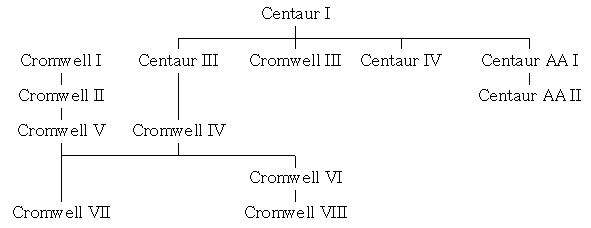
- Centaur I
- First draft. Armed with the Royal Ordnance QF 6 pounder (57 mm) gun (with 64 rounds of ammunition). It was used only for training. 1,059 produced.
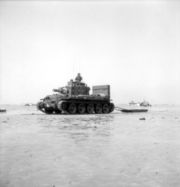
Porpoise was also used by the M7 Priest 105 mm howitzers.
- Centaur II
- Mark I with wider tracks and no hull machine gun. Experimental only.
- Centaur III
- Centaur armed with the 75 mm ROQF Mk V gun. In 1943, most Centaur I's were converted to III's, but a few remained as such. 233 produced.
- Centaur IV
- Centaur armed with a 95 mm howitzer (with 51 rounds of ammunition). This is the only version of the Centaur known to have seen combat, in service with the Royal Marines Armoured Support Group. The vehicles were fitted with wading gear to get them ashore. Trunking waterproofed the engine inlets and covers were fitted to the guns. 114 produced.[6]
- Centaur, AA Mk I
- Used a Crusader III, Anti-Aircraft Mk II turret fitted with twin 20 mm Polsten guns. Were originally deployed in Normandy, but withdrawn as unnecessary due to Allied air superiority. 95 were produced.
- Centaur, AA Mk II
- Used a Crusader III, AA Mk III turret with twin 20 mm Polsten AA guns.
- Cromwell I
- Exactly the same as the Centaur I, but using the Meteor engine. Only 357 produced due to the switch from the 6 pounder (57 mm) to the 75 mm gun.
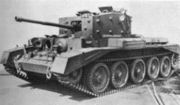
- Cromwell II
- Increased track width and removal of the hull machine gun to increase stowage. None produced.
- Cromwell III
- Centaur I upgraded with Meteor V12 engine. Only ~ 200 produced due to scarcity of Centaur I's.
- Cromwell IV
- Centaur III upgraded with Meteor engine. The most numerous variant with over 1,935 units produced.
- Cromwell IVw
- Meteor engine, and all welded hull.
- Cromwell Vw
- Cromwell built from the start with the 75 mm gun. Used a welded instead of riveted hull.
- Cromwell VI
- Cromwell armed with 95 mm howitzer. 341 produced.
- Cromwell VII
- Cromwell IV and V upgraded with additional armour, wider tracks, and additional gearbox. These were introduced very late in the war and did not see much in the way of combat. ~ 1,500 produced.
- Cromwell VIIw
- Cromwell Vw reworked to Cromwell VII standard.
- Cromwell VIII
- Cromwell VI with same upgrades as VII.
 Centaur IV behind Sword Beach, Normandy, France |
 |
 |
Vehicles based on chassis
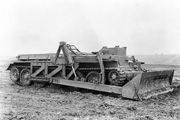
- Tank, Cruiser, Challenger (A30)
- The design combined lengthened Cromwell chassis and the 17-pounder gun in a new turret.
- SP 17pdr, A30 (Avenger)
- A version of the Challenger using a lighter open-topped turret.
- Centaur Dozer
- A Centaur with the turret removed and given a simple dozer blade operated by a winch. One of Hobart's Funnies. 250 produced. (version pictured uses hydraulic controls)
- Centaur Observation Post (OP)
- A Centaur with a dummy main gun, and extra radio telecommunications.
- Centaur Kangaroo
- A Centaur with turret removed to make space for passengers. (Few produced)
- Centaur Armoured Recovery Vehicle (ARV)
- A Centaur with turret removed, and replaced with winch fitted instead, and an optional A-frame.
- Cromwell Command
- The main gun was removed and it carried one No. 19 (Low Power) and one No. 19 (High Power) Wireless. These were used by brigade and divisional headquarters.[7]
- Cromwell Observation Post
- Cromwell IV, Cromwell VI, or Cromwell VIII fitted with extra radio equipment; 2 x No. 19 and 2 x No. 38 (portable) radios. The main gun was retained.[7]
- Cromwell Control
- Two No. 19 Low Power radio. Main armament kept. Used by regimental headquarters[7]
- Excelsior tank
- experimental design with elements of Infantry tank as a possible replacement for Churchill tank
- FV 4101 Charioteer
- Cromwell hull with a QF 20 pounder gun in a tall turret, designed in the 1950s. 200 produced.
Surviving vehicles
- Bovington Tank Museum, Dorset, England. Well preserved Cromwell IV displayed in interior location accessible to public on payment of entry fee to museum.
- Thetford Forest, Norfolk, England. Cromwell IV in outside location freely accessible to public. This tank is located on the A1065 two miles north of Mundford. Between January and May 1944 the area was occupied by armoured regiments of the 7th Armoured Division (Desert Rats) prior to their embarking for Normandy. The tank forms part of a 1998 memorial to the Division. It is in good display condition having been refurbished and painted as a replica of the tank Little Audrey of 1st Royal Tank Regiment.[8]
- The Royal Australian Armoured Corps Army Tank Museum, Puckapunyal, Victoria. Cromwell MkI shipped to Australia to assist with the up gunning of the Australian Cruiser tanks but did not arrive before that programme had been terminated. Repainted with the markings it arrived in Australia with, it is now under cover on display at the museum.
- The Israeli Armored Corps Museum in Latrun. Cromwell IV tank, that was used by the IDF in War of Independence (1948 - 1949).
- The Liberty Park in Overloon, The Netherlands. Cromwell IV tank, that remained on the battlefield after Operation Aintree during the Battle for Overloon in October 1944 in which the 11th Armoured Division was involved. This tank is on display in the museum, accessible to the public on payment of entry fee to museum.
There are two surviving Centaur IV CS- both are displayed as D Day memorials.
See also
- Vickers Tank Periscope MK.IV
Notes
- ↑ WWII Vehicles
- ↑ 2.0 2.1 "The A27M Cromwell tank". http://freespace.virgin.net/shermanic.firefly/a27m.html.
- ↑ Fletcher The Great Tank Scandal p65-66
- ↑ For their part, Rolls-Royce took over Rovers work on the British Whittle jet engines.
- ↑ Fletcher, p 100
- ↑ Ness, Leland. Jane's World War Two Tanks and Fighting Vehicles. p. 22.
- ↑ 7.0 7.1 7.2 David Fletcher, Richard C. Harley, Peter Sarson. Cromwell Cruiser tank 1942-1950 (New Vanguard series). Osprey Publishing. p. 34. http://books.google.co.uk/books?id=aHzvwaNv3vQC&pg=PA33&lpg=PA33&dq=cromwell+tank+op&source=bl&ots=8ejo540Q_F&sig=OcRCB22cHwm6956vKIyvR67Ub9E&hl=en&ei=t-MwSp6OHtuOjAfUuPDbBw&sa=X&oi=book_result&ct=result&resnum=3#PPA34,M1.
- ↑ "The Desert Rats, 7th Armoured Division, Thetford Forest Memorial". http://myweb.tiscali.co.uk/desertrats. Retrieved March 14, 2006.
References
- "Britain's Cruiser Mk VIII Cromwell (A27M) Tanks". World War II Vehicles. http://www.wwiivehicles.com/unitedkingdom/cruiser/mk-viii-a27m.asp. Retrieved 12 May 2009.
- Bishop, Chris (2002). The Encyclopedia of Weapons of World War II: The Comprehensive Guide to Over 1,500 Weapons Systems, Including Tanks, Small Arms, Warplanes, Artillery, Ships and Submarines. Sterling Publishing Company. p. 26. ISBN 9781586637620. http://books.google.co.uk/books?id=JZ9cSQNeK9cC&printsec=frontcover#PPA26,M1.
- David Fletcher (1993). The Universal Tank: British Armour in the Second World War Part 2. HMSO. ISBN 0-11-290534-X.
External links
- OnWar specifications: Cromwell I, Cromwell IV
- Henk of Holland
- ""Crusier tank A27M Cromwell"" (in Danish). Photo Gallery of WW2. http://ww2photo.mimerswell.com/tanks/gb/crus/crom/crom.htm.
- "The A27M Cromwell tank". Shermanic Firefly. http://freespace.virgin.net/shermanic.firefly/a27m.html.
|
|||||||||||
|
|||||
|
|||||
|
|||||||||||||||||
|
|||||
|
||||||||||||||
| British armoured fighting vehicle production during World War II |
|---|